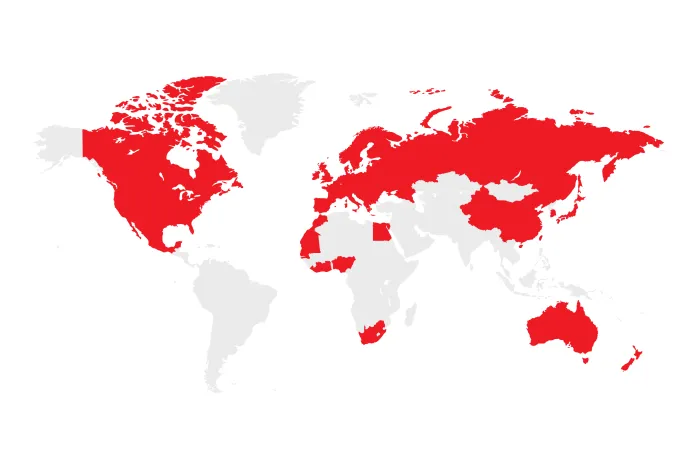Find out what rabbit haemorrhagic disease is
Rabbit haemorrhagic disease (RHD) is one of the major viral diseases affecting rabbits (Oryctolagus cuniculus). It is characterised by acute, lethal and highly contagious hepatitis. It is caused by rabbit haemorrhagic disease virus (RHDV), which belongs to the Lagovirus genus and the Caliciviridae family.
The first documented outbreak of rabbit haemorrhagic disease occurred in China, in the province of Jiangsu, in 1984, when the first outbreak appeared in some Angora rabbits imported from Europe. In less than one year, the disease caused the death of approximately 14 million domestic rabbits in China. Since then, the virus has spread rapidly through rabbit populations in Asia, Europe, Oceania and the Americas. Outbreaks of this pathology have now been detected on all continents, including Africa and Oceania.

The countries where a case of RHD has been reported appear in red.
Aetiology
In 2010, the emergence of a new virus related to RHDV (RHDV2) partially changed the epidemiology of this disease. This new virus presented phylogenetic and antigenic differences from the classic virus. Therefore, two different serotypes were described:
- RHDV, Gl.1 or classic strain: first described in China in 1984.
- RHDV2, RHDVb, Gl.2 or variant strain: discovered in 2010 in France.
Clinical signs
Three different clinical courses have been described, depending on the clinical progression of the disease. However, the most common is the hyperacute form, which is characterised by sudden death without clinical signs.
Mortality varies depending on the strain of RHD and the age of the rabbit:
- RHDV or classic strain: high mortality (80-90%) in adult rabbits.
- RHDV2 or variant strain: variable mortality (50-90%) and can affect rabbits 7-15 days old or older.
In the acute or subacute form, rabbits can develop fever, anorexia, apathy, neurological symptoms, sometimes respiratory signs, jaundice, epistaxis, etc.

Transmission
The main routes of transmission are through direct contact with infected animals and indirect contact through fomites such as footwear, contaminated food, mechanical vectors, etc.
As it is a very resistant virus in the environment, the risk of a rabbit becoming infected is relatively high. In fact, several cases have been described in indoor rabbits, which did not have access to the outside, and in which the transmission route is unknown.
Diagnosis
The diagnosis of rabbit haemorrhagic disease is based on the detection of the virus by PCR. The liver is the ideal sample since it is the organ that contains the highest viral titres.
Another technique used is serology. However, interpreting the results can be complicated, as it is impossible to differentiate between antibodies generated after vaccination and the infection.
Treatment
There is no specific treatment, so only supportive treatments can be implemented.
As it is a serious disease with a high mortality rate, prevention through vaccination is essential. Fortunately, several RHD vaccines are currently available.
References
Lavazza, A.; Capucci, L. Chapter 3.6.2.—Rabbit haemorrhagic disease. In Manual of Diagnostic Tests and Vaccines for Terrestrial Animals 2021; OIE: Paris, France, 2021; pp. 1389–1406
Kerr PJ, Kitchen A, Holmes EC. Origin and phylodynamics of rabbit hemorrhagic disease virus. J Virol. 2009 Dec;83(23):12129-38. doi: 10.1128/JVI.01523-09. Epub 2009 Sep 16. PMID: 19759153; PMCID: PMC2786765
Capucci L., Cavadini P., Lavazza A. 2022. Viral haemorrhagic disease: RHDV type 2 ten years later. World Rabbit Sci., 30: 1-11. https://doi.org/10.4995/wrs.2022.16505
